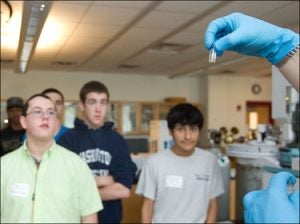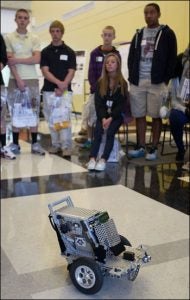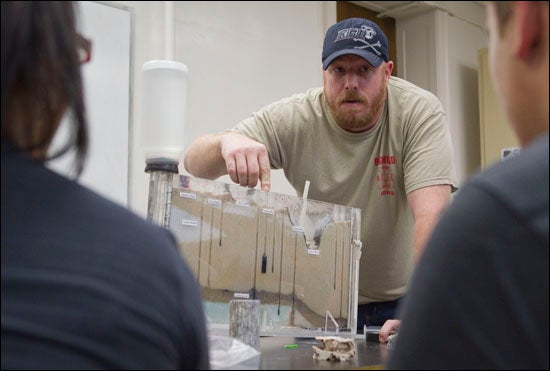EARLY EXPOSURE
High school students explore STEM majors at ECU
The clear box of sand and soil in front of East Carolina University graduate student Shawn Thieme resembled an ant farm without any insects. With a medicine dropper, he inserted red dye into an opening at the top. Five students watched closely as it seeped down through the layers of dirt to form a red splotch in a lower level of earth.
Thieme then grabbed another syringe and started pumping water out of a well running through the soil.
“Watch as I pump how that (red) plume starts to migrate toward that well,” he told them. The simulation shows how contaminates from gas stations and landfills could pollute a water supply over time.
This is what geologists – and Thieme in particular – study at ECU. The topics are much broader in scope than what many believe, said Mary Farwell, director of undergraduate research. She hopes early exposure to science, technology, engineering and math (STEM) curriculum and careers will change that.

High school students learned about conducting chemical tests for analyzing drugs and testing crime scenes during a visit to ECU April 19.
Approximately 100 high school students visited campus April 19 to participate in High School STEM Day activities highlighting the university’s programs. The event targeted juniors and seniors and drew participants from Beaufort, Onslow and Pitt counties.
“We want to make sure students know what goes on here (at ECU),” said Farwell, who organized the event with help from two colleges, the Center for STEM Education and the N.C. Eastern Region. “It’s not just sitting in class. There’s a lot of hands-on stuff, too.”
Teachers chaperoning the high school students said the event helps get students interested in pursuing math and science.
“I think they see things that they wouldn’t get to see in a regular classroom,” said Heather Scott, a math teacher at Washington High School.
“We don’t have the technology to do this,” she added, gesturing around an analytical chemistry lab where assistant professor Anthony Kennedy showed students how to conduct gas chromatography. It’s a common test used for analyzing drugs and in processing crime scenes, he told them.
“And it’s good that college students are in there,” Scott continued. “They’re explaining what they study in their major and what they’re going to do with it.”
The emphasis of multiple High School STEM Day activities was job skills. George Wang, an assistant professor in the Department of Construction Management, taught how to conduct soil tests at a building site while a colleague demonstrated the use of land surveying equipment.
Farwell said it’s important for students to see where a college degree could take them.
“We feel students don’t really understand that in the STEM majors, they can really walk into a job when they graduate,” she said. “A lot of other (programs) can’t say that.”
A favorite among visiting students was a Department of Engineering demonstration featuring robots built by ECU students.
“There was one robot, if it came too close to a wall, it would back up and change directions,” explained Joseph DeMatty, a junior at Jacksonville High School. “There was another one that would follow a black line, so it could sense the colors between black and white. I thought it was pretty cool. It was my favorite.”
“Knowing that people can actually work those and make them is pretty cool,” agreed Logan Webb, a sophomore at D.H. Conley High School. “I’m interested in science in math so I came to this to see what my options are.”

An engineering demonstration that featured robots made by ECU students was a favorite among the visiting high schoolers.
